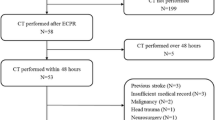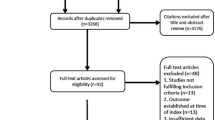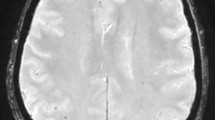Abstract
Background
Microsusceptibility changes in the brain are well known to correspond with microbleeds or micrometal fragments in adults, but this phenomenon has not been explored well in children.
Objective
To assess imaging and clinical characteristics of children with multiple foci of microsusceptibility changes using susceptibility-weighted imaging (SWI).
Materials and methods
Between 2006 and 2008, 12 children with multiple foci of microsusceptibility on SWI without corresponding abnormal signal on conventional MRI were identified and were retrospectively assessed.
Results
The locations of foci of microsusceptibility included the cerebral white matter, basal ganglia, brainstem and cerebellar white matter, without any clear systematic anatomic distribution. CT (n = 5) showed no calcification at the locations corresponding to the microsusceptibility on SWI. Conventional MR imaging showed white matter volume loss (n = 5), delayed myelination (n = 2), acute infarction (n = 1), chronic infarction (n = 1), meningitis (n = 1), slight signal abnormality in the white matter (n = 1) and no abnormal findings (n = 1). Follow-up SWI (n = 3) showed no change of the microsusceptibility foci. Interestingly, all children had a history of heart surgery under extracorporeal circulation for congenital heart disease.
Conclusion
Multiple foci of microsusceptibility can be seen in the brain on SWI in children with congenital heart disease who underwent heart surgery with extracorporeal circulation.



Similar content being viewed by others
References
Roob G, Lechner A, Schmidt R et al (2000) Frequency and location of microbleeds in patients with primary intracerebral hemorrhage. Stroke 31:2665–2669
Kato H, Izumiyama M, Izumiyama K et al (2002) Silent cerebral microbleeds on T2*-weighted MRI: correlation with stroke subtype, stroke recurrence, and leukoaraiosis. Stroke 33:1536–1540
Naka H, Nomura E, Wakabayashi S et al (2004) Frequency of asymptomatic microbleeds on T2*-weighted MR images of patients with recurrent stroke: association with combination of stroke subtypes and leukoaraiosis. AJNR 25:714–719
Fazekas F, Kleinert R, Roob G et al (1999) Histopathologic analysis of foci of signal loss on gradient-echo T2*-weighted MR images in patients with spontaneous intracerebral hemorrhage: evidence of microangiopathy-related microbleeds. AJNR 20:637–642
Mori N, Miki Y, Kikuta K et al (2008) Microbleeds in moyamoya disease: susceptibility-weighted imaging versus T2*-weighted imaging at 3 Tesla. Invest Radiol 43:574–579
Kikuta K, Takagi Y, Nozaki K et al (2007) Histological analysis of microbleed after surgical resection in a patient with moyamoya disease. Neurol Med Chir (Tokyo) 47:564–567
Ishikawa T, Kuroda S, Nakayama N et al (2005) Prevalence of asymptomatic microbleeds in patients with moyamoya disease. Neurol Med Chir (Tokyo) 45:495–500
Kikuta K, Takagi Y, Nozaki K et al (2005) Asymptomatic microbleeds in moyamoya disease: T2*-weighted gradient-echo magnetic resonance imaging study. J Neurosurg 102:470–475
Vernooij MW, Haag MD, van der Lugt A et al (2009) Use of antithrombotic drugs and the presence of cerebral microbleeds: the Rotterdam Scan Study. Arch Neurol 66:714–720
Tong KA, Ashwal S, Holshouser BA et al (2003) Hemorrhagic shearing lesions in children and adolescents with posttraumatic diffuse axonal injury: improved detection and initial results. Radiology 227:332–339
Santhosh K, Kesavadas C, Thomas B et al (2009) Susceptibility weighted imaging: a new tool in magnetic resonance imaging of stroke. Clin Radiol 64:74–83
van Gorp MJ, van der Graaf Y, de Mol BA et al (2004) Bjork-Shiley convexoconcave valves: susceptibility artifacts at brain MR imaging and mechanical valve fractures. Radiology 230:709–714
van Gorp MJ, de Mol BA, Bakker CJ et al (2003) Black holes on MR images of the brain of patients with Bjork-Shiley heart valves: additional observation in three cases. AJNR 24:512–514
Nighoghossian N, Hermier M, Adeleine P et al (2002) Old microbleeds are a potential risk factor for cerebral bleeding after ischemic stroke: a gradient-echo T2*-weighted brain MRI study. Stroke 33:735–742
Wardlaw JM, Lewis SC, Keir SL et al (2006) Cerebral microbleeds are associated with lacunar stroke defined clinically and radiologically, independently of white matter lesions. Stroke 37:2633–2636
Ueno H, Naka H, Ohshita T et al (2008) Association between cerebral microbleeds on T2*-weighted MR images and recurrent hemorrhagic stroke in patients treated with warfarin following ischemic stroke. AJNR 29:1483–1486
Reichenbach JR, Venkatesan R, Schillinger DJ et al (1997) Small vessels in the human brain: MR venography with deoxyhemoglobin as an intrinsic contrast agent. Radiology 204:272–277
Haacke EM, Xu Y, Cheng YC et al (2004) Susceptibility weighted imaging (SWI). Magn Reson Med 52:612–618
Tong KA, Ashwal S, Obenaus A et al (2008) Susceptibility-weighted MR imaging: a review of clinical applications in children. AJNR 29:9–17
Haacke EM, Mittal S, Wu Z et al (2009) Susceptibility-weighted imaging: technical aspects and clinical applications, part 1. AJNR 30:19–30
Akter M, Hirai T, Hiai Y et al (2007) Detection of hemorrhagic hypointense foci in the brain on susceptibility-weighted imaging clinical and phantom studies. Acad Radiol 14:1011–1019
Barkovich AJ, Kjos BO, Jackson DE Jr et al (1988) Normal maturation of the neonatal and infant brain: MR imaging at 1.5 T. Radiology 166:173–180
Tavani F, Zimmerman RA, Clancy RR et al (2003) Incidental intracranial hemorrhage after uncomplicated birth: MRI before and after neonatal heart surgery. Neuroradiology 45:253–258
Krull F, Latta K, Hoyer PF et al (1994) Cerebral ultrasonography before and after cardiac surgery in infants. Pediatr Cardiol 15:159–162
Mahle WT, Tavani F, Zimmerman RA et al (2002) An MRI study of neurological injury before and after congenital heart surgery. Circulation 106:I109–114
Author information
Authors and Affiliations
Corresponding author
Rights and permissions
About this article
Cite this article
Niwa, T., Aida, N., Takahara, T. et al. Imaging and clinical characteristics of children with multiple foci of microsusceptibility changes in the brain on susceptibility-weighted MRI. Pediatr Radiol 40, 1657–1662 (2010). https://doi.org/10.1007/s00247-010-1665-z
Received:
Revised:
Accepted:
Published:
Issue Date:
DOI: https://doi.org/10.1007/s00247-010-1665-z




